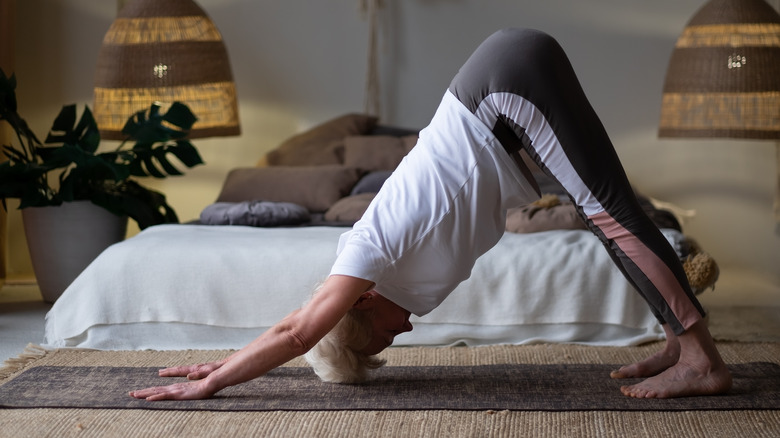Tips To Ease 'Tech Neck' Pain
There's no question that our mobile devices make our lives easier, but spending too much time looking at them can lead to problems with posture. Specifically, looking down for long periods of time can lead to "tech neck," a position in which your head is forward, your back is hunched slightly, and your shoulders curve toward the front of your body (via Healthline).
Tech neck can become a dangerous condition because it tightens and flattens all of the muscles and ligaments at the front of your neck while lengthening the ones at the back of your neck. These muscles and ligaments are important because they support your head, which weighs about 10 pounds. When you tilt your head forward, the weight your neck supports can double. Over time, this unusual amount of stress on the neck can result in pain. Not only that, but it wears down the bones in your neck, and that can lead to even more damage, such as herniated discs, according to WebMD. Tech neck is a real thing, but the good news is that there are ways you can ease pain and avoid injuries.
Stretch your neck muscles
One of the easiest ways to treat the pain of tech neck is by stretching your neck. It doesn't take much time, and it offers immediate relief. Plus, when you take time to stretch, you're taking your eyes away from the screen.
One stretching exercise Verywell Health suggests is a simple neck twist. Without lifting or lowering your chin, look over one shoulder, stop when you feel a light stretch in your neck, and hold for 20 seconds. Repeat looking over your other shoulder. Another stretch involves tilting your head to one side while looking forward. For this stretch, think of touching your ear to your shoulder. Hold for 20 seconds and repeat on the other side.
Chin tucks are another stretch that can loosen tight neck muscles. While facing forward, lower your chin to your chest and hold for 20 seconds, before repeating four more times. Looking up at the ceiling is another stretch that can help ease neck tension. Tilt your head back as if you are looking at the ceiling and hold for 20 seconds (via Verywell Health).
Strengthen your neck, shoulders, and chest
Strengthening all of the muscles connected to your neck can help combat pain. Healthline explains that the exaggerated nod exercise counteracts looking down by stretching the front of your neck. To do this, sit with your shoulders relaxed, and tilt your head back with your mouth closed. Once you're looking at the ceiling, open your mouth while tilting your head back one or two more inches, and then close your mouth again. Repeat about three times a day.
To work and open up your shoulders and chest, practice downward-facing dog. For this exercise, stand with your feet hip-width apart and place your hands on the floor. Push your hips toward the ceiling while keeping your neck in line with your back. Hold for a few seconds while taking deep breaths. Another exercise that helps tackle tech neck is the cobra pose. In this exercise, you start out on your belly. Lift your upper body off the floor, with only a little bit of support from your hands, before holding for about 15 seconds (via Everyday Health).
Change how you look at screens
Since giving up your phone or tablet is probably not going to happen, altering how you use them can help ease tech neck pain. One way to do this is to bring your device up to eye level when you're looking at it. You can either hold it or use a stand that holds it at eye level. In addition, there are apps that help you hold your device at better angles. Another tip to fight tech neck is keeping your desktop computer screen at eye level, too. If you work from a laptop, use a separate keyboard and raise your laptop to eye level, per Harvard Health.
Another change worth trying is taking breaks from looking down. Harvard Health suggests looking up from your device every 15 minutes to help counteract the effects of tech neck. You should also shift your position often so your body isn't frozen in a single position for hours at a time.
Limit screen time
Limiting your screen time might be the toughest tip of all, but it may be the most beneficial. You don't have to do this all at once, and every little bit helps. Believe it or not, there are several ways that you can limit your screen time without feeling like you're missing out.
Interesting Engineering suggests a good way to start is by not looking at your phone while you eat. Take that time to enjoy your food and give your eyes a break. Limit how much time you spend online by setting a timer or using an app. Schedule a certain time of day when you check emails or other forms of communication, and don't check work emails while you're at home.
Try replacing screen time with another hobby. Coloring, drawing, reading, walking, hiking, fishing, yoga, putting puzzles together, playing board games, and learning a new language or how to play an instrument are just a few activities to try instead of looking at your phone (via PsychCentral).
Other strategies for coping with pain
Tech neck is a form of poor posture, and one way to keep pain at bay is by practicing good posture whenever you can. Dr. Rahul Shah, Board Certified Orthopedic Spine and Neck Surgeon, told Eat This, Not That! that tech neck is just one of many poor posture habits that keep the head out of proper alignment. Regular exercise is one way to offset poor posture because moving the body "primes the muscles to assume their optimal posture," Shah said.
Aside from practicing good posture, applying ice packs or heat to your neck can relieve pain. The Mayo Clinic explains that a massage can help relieve tension in neck muscles and ease the pain. If you cannot seem to alleviate pain in your neck, or if you develop a high fever, weakness, or any other worrisome symptoms, you should talk with a doctor because you may have an underlying problem that needs to be addressed.






